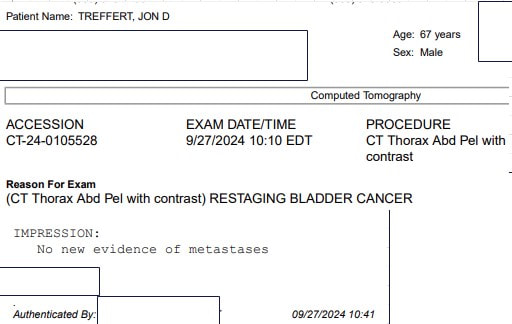|
I began my 7th cycle of enfortumab vedotin and pembrolizumab (Padcev+Keytruda) on May 31. I continued with pembrolizumab only on June 21. On September 13 I began my 6th cycle of pembrolizumab only. This is my second follow-up using CT with contrast since changing to immunotherapy alone. I would like to schedule a PET/CT and/or circulating tumor DNA to confirm - but I am happy to see a report of no evidence of recurrence or new disease by CT.
0 Comments
My cancer journey is documented on this blog. After over 30 years of leading software development of medical devices for the detection and treatment of cancer, I've had the opportunity to view the state of the industries I've contributed to as a member of the population they exist to serve. I've also begun work as a patient advocate and have had a chance to meet many fine folks who have walked or are walking through a bladder cancer (or other cancer) journeys. I now have a series of recommendations and new causes to pursue:
Educate and advocate for PET/CT staging of advanced muscle invasive bladder cancer After transurethral resection of my bladder tumor (TURBT), pathology confirmed it as invasive high grade papillary urothelial cell carcinoma with musclaris propria present. Anatomic imaging - CT and MRI, with and without contrast, were ordered for staging. No incidental findings were observed. I then requested a PET/CT. A whole-body PET/CT scan found locoregional spread to left presacral and left pelvic lymph nodes. This significantly changed the standard of care guidance for my case. Review of the current data demonstrates the promise of PET/CT relative to CT and MR for detection of lymph node or metastatic involvement in muscle invasive bladder cancer (MIBC). Standardization of the process may lead to wider adoption and reimbursement and reduced understaging of MIBC. Educate and advocate for bladder sparing treatment with trimodality therapy (particularly with protons) A majority of patients with muscle invasive bladder cancer undergo radical cystectomy (surgical removal of bladder, lymph nodes and often other nearby organs) and a urinary diversion: ileal conduit (incontinent diversion), neobladder(continent diversion) or continent cutaneous diversion. There remains a significant rate of recurrence with radical cystectomy (RC). There may also be neoadjuvant or adjuvant chemotherapy to minimize microscopic disease. Trimodality therapy is a bladder sparing option which employs radiation therapy and concurrent chemotherapy following TURBT. Having lead software development for a new proton therapy system, I had intended to pursue trimodality therapy with radiation delivered by a proton therapy system. I had access at a facility 20 minutes away in Knoxville or with the system I had lead software development for in Franklin Tennessee (where my sister now lives). I was initially disappointed to see that bladder cancer was not listed as an indication on the web site of either facility. After inquiring, I was happy to learn that a limited number of bladder cancers and lymph nodes had been treated at both facilities. A recent publication concluded that their "multi-institutional study provides the best evidence to date showing similar oncological outcomes between radical cystectomy and trimodality therapy for select patients with muscle-invasive bladder cancer. These results support that trimodality therapy, in the setting of multidisciplinary shared decision-making, should be offered to all suitable candidates with muscle-invasive bladder cancer and not only to patients with significant comorbidities for whom surgery is not an option.” I believe that proton therapy provides improved sparing of health tissue and quality of life and had initiated a consultation. A recent review comparing proton and x-ray therapy in MIBC showed improved overall survival with proton therapy - calling for more study and follow up. Access and reimbursement remains a challenge for the proton therapy industry and trimodality therapy for bladder sparing seems to me to be a significant opportunity to collaborate in demonstrating its benefits. Educate and advocate for potential bladder sparing with EV/pembro I knew that in Tennesse, my best route for approval of proton therapy was through Medicare. On learning of my diagnosis I resigned my job, left my employer insurance and applied for Medicare Part B (I was 66). My application was delayed (although I had sent in all the required forms) and while I was waiting, I read of the practice changing results presented for enfortumab vedotin and pembrolizumab (EV/Pembro) in the EV-302 phase III trial. My Medicare was approved on Dec 1, 2023 (retroactive to Nov 1, 2023). I began treatment with EV/pembro on Dec 11, 2023. On Dec 15, the FDA granted accelerated approval of EV/pembro as a first line option for locally advanced or metastatic urothelial cell cancer. 29% of the participants in the EV-302 trial had a complete pathological response. The details are presented in this blog - I currently have no evidence of disease by imaging or circulating tumor DNA and at present have no plans to pursue chemoradiation or surgery. More data needs to assembled following high responders to EV/pembro to quantify durability of the response to see if trimodality or RC can be avoided. As part of this activity, guidance for dose de-escalation for high responders to EV/pembro needs to be generated. Advance biomarker development to predict response to EV/pembro EV/pembro is an all comers treatment not requiring biomarker tests for inclusion. Tests exist today to evaluate expression of PD-L1 to predict response to pembrolizumab. I did have genetic testing done (after beginning treatment) which showed I have a PD-L1 CPS score of 10 - indicating likelihood of benefit to pembrolizumab. Enfortumab vedotin is an antibody drug conjugate which binds to an immunoglobulin like protein Nectin-4. Nectin-4 is overexpressed in 97% of bladder cancers. The diagnostic and prognostic potential of Nectin-4 is currently being explored. A PET radiotracer (68)Ga-N188 has been developed for imaging of Nectin-4 and may offer a tool for diagnosing bladder cancer and selecting patients for treatment with/predicting response to enfortumab vedotin. It may also be possible someday to engineer theranostic pairs employing alpha and beta emitting radionuclides similar to those available today for prostate cancer. Recognize importance of insurance navigation resources As noted above, I orignally pursued enrolling in Medicare to increase likelihood of reimbursement for proton therapy. I was extremely fortunate to be recommended to an excellent Medicare guide shortly after I was diagnosed with cancer. He recommended a Medigap G plan for my Medicare Part C. The Medigap coverage adds a monthly premium (in total less than my previous private insurance) - however, along with Part A, B and a Part D drug plan - my medical costs for my EV/pembro treatment have been very manageable. As described in my first blog posts, in 2017, I began a (first) health journey, losing 100 lbs. and reversing type 2 diabetes, and after 30 years, began e-biking (I ride the beautiful hills of East Tennessee). I joined the Great Cycle Challenge, where tens of thousands of bikers spend a month riding to raise research funds for children’s cancers. I am riding this month for the seventh year. Although it is devastating to children and their families, due to relatively smaller numbers receives only 4% of federal research funds. Bladder cancer receives roughly 1% of federal funds. So, like the Bladder Cancer Advocacy Network (BCAN), this activity provides young investigators with the funds they need to advance their ideas that may lead to practice-changing breakthroughs such as that I am benefiting from. Data shows the benefits of exercise for cancer patients, and I continue to bike year-round during my journey.
BCAN discusses exercise and cancer here. You can find my Great Cycle Challenge challenge story here I had a genetic test done after I began my treatment (enfortumab vedotin + pembrolizumab / Padcev+Keytruda). This treatment performed so well in its phase 3 trial that no pre-testing (e.g. for PD-1 ) is required for patients presenting with locally advanced or metastatic muscle invasive bladder cancer.
I did request genetic testing where I found I had a PD-L1 CPS score of 10, which indicated that Keytruda should be effective (there is currently no approved biomarker to predict effectiveness of Padcev). I also had germline testing. This is a genetic test that looks for inherited mutations in your DNA that may increase your risk of developing certain types of cancer. These mutations are present in virtually all cells of your body and can be passed down from one generation to the next. I wanted my daughter to be aware of any mutation that might increase her cancer risk. The test found one variation in the CHEK2 gene. When the results came in I met with a genetic counselor who told me that the most recent data suggest a possible increase in breask cancer risk - but that the probability does not warrant any more than the screening which is currently recommended for all women. Germline testing for cancer patients is currently underutilized - I am glad, for my daughter's sake that my oncologist suggested it. |
AuthorI began a health journey in the fall of 2017 - losing 100 lbs and reversing type II diabetes. Archives
June 2025
Categories |



 RSS Feed
RSS Feed